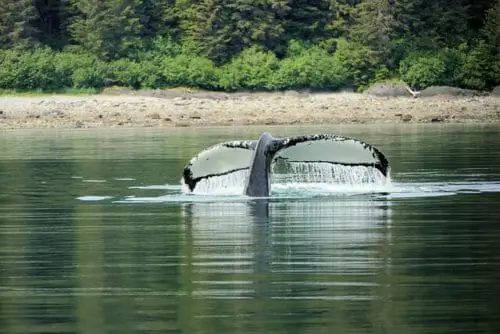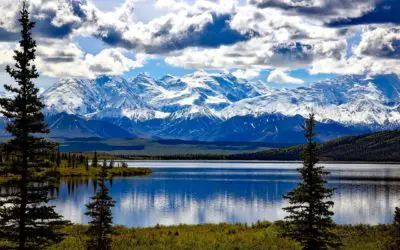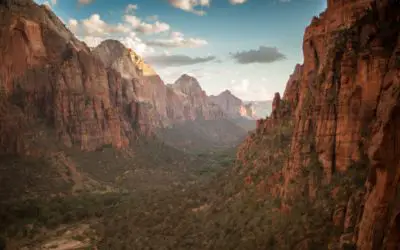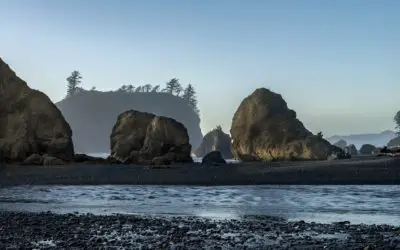Whale watching is a personal pastime of mine, and Alaska is a bucket list destination for wildlife enthusiasts. Every summer, whales make their long migration from the warmer waters of Mexico and Hawaii to the food-rich waters of Alaska. Travelers who dream of cruising the Inside Passage or the Gulf of Alaska arrive in time for one of nature’s greatest spectacles.
When you’re traveling around Alaska, I recommend saving time for a whale-watching excursion. Even if you don’t wish to book a multi-day cruise, there are full-day and half-day whale watching tours available for a big small group. You can depart directly from the port and spend the day admiring these inspirational creatures. That gives you more flexibility to combine your whale watching tour with land trips into the Alaskan backcountry to see the northern lights, camping in the Alaskan national parks or go for some epic hiking in Alaska.
If whale-watching falls on your must-do Alaska list, follow this guide to plan an exhilarating excursion for the best whale watching in Alaska. Find out the best time to visit, top whale watching bases, and tips for an enjoyable time. And when you finally see humpbacks, orcas, and more, I promise it’ll be a life-changing moment.
Alaska Whale Watching Guide
Best Time to Go Whale Watching in Alaska | Best Whale Watching Destinations in Alaska | Juneau | Icy Strait Point | Gustavus | Kenai Fjords National Park | Glacier Bay National Park and Preserve | Kodiak Island | Lake Clark National Park and Preserve | Tips for an Enjoyable Alaska Whale Watching Cruise | Pack the Right Clothes | Prepare for Motion Sickness | Bring Your Camera | Bring Binoculars | View the Scenery Around You | Practice Patience | Only Sail with Reputable Companies | How to Practice Whale Watching Ethics
Best Time to Go Whale Watching in Alaska
Alaska whale watching season stretches from May-September, and this parallels the whale migration to Alaskan waters. Whales start to arrive in Alaska in April to engorge their bodies with food before returning to warmer Pacific waters. While cruise season lasts until September, May-August presents the best opportunities to spot whales.
May and June are Alaska’s driest months of the year and create more comfortable conditions for whale-watching cruises. July and August present the warmest weather conditions, but it’s also peak tourist season. If you visit during July or August, expect large crowds jostling for cruise tickets and whale watching tours.
Best Whale Watching Destinations in Alaska
With its dramatic setting on the North Pacific Ocean and the Bering Sea, Alaska hosts many ports to embark on whale-watching excursions. Several ports lie on the Inside Passage, the coastal route famous for its large populations of migrating whales.
While most travelers book Inside Passage cruises to spot whales, I think you get a more intimate experience directly from the port. You’ll sail the frigid waterways with local operators who have more in-depth knowledge of seeing whales in their surroundings. Plus, it gives you chances to learn about the Alaskan culture and the connections whales have to ancient traditions.
1. Juneau
While Juneau is Alaska’s capital, the seaside town is more famous for its marine life just offshore. The settlement sits on the Inside Passage and makes a glorious starting point for whale-watching tours. Although many cruise ships stop at Juneau, you’ll have a more intimate experience booking a Juneau whale watching tour.
Juneau hosts numerous outfitters for whale-watching excursions, and Juneau Whale Watch is an excellent place to start. Make the short journey to Auke Bay to begin your quest to find humpback whales, orcas, sea lions, Dall’s porpoises, and harbor seals. The sea creatures steal the spotlight, but you could also spot brown bears and bald eagles. Juneau Whale Watch also has the option of combining a detour to the mighty Mendenhall Glacier as you search for whales.
If you’re looking to include a land tour on your cruise, Gastineau Guiding Company has multiple options. A hiking shore excursion to Mendenhall Glacier makes a fantastic addition to discover the scenery around Juneau. The hike takes you to coastal forests, tumbling waterfalls, and the mammoth glacier. And with other waterways like the Lynn Canal and Favorite Channel nearby, Juneau is the perfect base for whale watchers.

2. Icy Strait Point
Located in Hoonah, Icy Strait Point is another picture-perfect stop nestled on the Inside Passage. While Icy Strait Point also serves as a cruise ship port, you’re better suited to making it your departure location. Multiple waterways converge to create nutrient-rich waters around the headland and attract hungry marine creatures during summer. In other words, whale sightings are guaranteed when you cast away from Icy Strait Point during whale season.
What makes Icy Strait Point stand out compared to other Alaskan ports is its intimate connection with the aboriginal people. The Hoonah Tlingit people have a deep connection to the area with their 10,000+ year history around Icy Strait Point. Hoonah hosts a largely Tlingit community, and the Native Alaskans make the port even more special.
Icy Strait Whale Adventures brings the Hoonah Tlingit hospitality to your vessel when you explore the Southeast Alaska waterways. Since the entire crew are descendants of the Hoonah Tlingit, you’ll gain tremendous insight into their ancient culture. Your captain will steer you close enough to the feeding grounds for magnificent views without disturbing wildlife. From the viewing platforms, you’ll spot humpback whales, orcas, sea lions, Dall’s porpoises, sea otters, and more.

3. Gustavus
Gustavus lies on an inlet just beyond Glacier Bay and offers a thrilling base for whale-watching excursions. The small town rests on the Inside Passage and makes an excellent base to explore Icy Strait. And Gustavus allows you to take a Glacier Bay National Park cruise without booking a full Inside Passage itinerary. In addition to being the gateway to Glacier Bay, Gustavus sits adjacent to Tongass National Forest for thrilling hiking expeditions.
The TAZ has completed thousands of whale watching tours and offers daily excursions into Icy Strait and Point Adolphus. You’ll enter the humpback whale feeding waters just outside of Glacier Bay, where tons of marine species congregate. With the help of the onboard naturalist, you have the chance to spot humpback whales, orcas, sea lions, sea otters, Dall porpoises, brown bears, bald eagles, and puffins. The TAZ also offers private charters for more intimate experiences around Gustavus.

4. Kenai Fjords National Park
With its deep-blue fjords and retreating glaciers, Kenai Fjords makes an excellent stop for an Alaska whale watching tour. Boat tours into the Kenai Fjords reveal a breathtaking convergence of land, sea, and ice. 40 glaciers retreat from the Harding Icefield, while icebergs and sea stacks fill the waterways. The rich waters of the coastal fjords attract a wide range of whale species to feed throughout the year. Humpback whales and orcas take centerstage during summer, and gray whales pass through the fjords during spring.
Departing for Kenai Fjords National Park from Seward, Major Marine Tours is the premier outfitter to explore the Kenai Fjords and nearby Resurrection Bay. The company offers multiple cruises to explore the enormous glaciers, rocky cliffs, sparkling fjords, and vast wildlife of the park. The cruise ship enchants you with views of orcas, humpback whales, fin whales, minke whales, and gray whales. In addition to the numerous whale species, you might find sea lions, sea otters, puffins, and bald eagles. Major Marine has everything from small ship adventures to half-day cruises in tranquil waters for the experience right for you.
From Seward or nearby Whittier, you can also cruise to Prince William Sound for whale watching opportunities. The pristine bay contains glaciers, islands, snow-capped peaks, and vast wildlife. These tranquil waters host stunning species, such as humpback whales, orcas, minke whales, Dall’s porpoises, sea lions, sea otters, harbor seals, mountain goats, and black bears.

5. Glacier Bay National Park and Preserve
Situated in Southeast Alaska, Glacier Bay National Park is almost exclusively explored by seafaring passengers. While icy pinnacles, sparkling fjords, and tidewater glaciers highlight Inside Passage cruises, Glacier Bay is also a humpback whale hotspot. Cruise ship passengers often feel a jolt of adrenaline when they witness a whale breaching near the vessel. If you can snap a photo of a humpback whale with a dramatic mountain backdrop, it will be an unforgettable memory.
With the Fairweather Mountains towering above you, cruising Glacier Bay is an essential Alaska experience. Inside Passage cruise ships typically spend a full day prowling around the icy expanses of Glacier Bay. And during cruise season, that gives you ample opportunity to spot whales from the ship. Marine creatures flock to these nutrient-rich waters to feed, and it creates a jaw-dropping spectacle for wildlife enthusiasts.

6. Kodiak Island
If you wish to detour far from the Inside Passage, Kodiak Island may be the best place to go. Across the Gulf of Alaska, Kodiak Island is Alaska’s largest island and a vital fishing hub. Kodiak Island sits right on a migration path, and the salmon-rich waters welcome the return of whales every April. The island even hosts the jovial Whale Fest to celebrate the majestic sea creatures.
Several whale-watching charter boats operate around Kodiak Island to give you a variety of options. Kodiak Scenic Tours is a local operator that briefs you on the history and fishing industry of the island. As you depart the harbor, you’ll search for whales in the rich waters around the Kodiak Channel, Miller Point, and Buskin River watershed.
In addition to gray whales, fin whales, and humpback whales, keep your eyes peeled for sea lions, sea otters, and puffins. When you return to shore, include a bear viewing tour around Kodiak Island’s 1.9-million-acre wildlife refuge.
7. Lake Clark National Park and Preserve
Lake Clark National Park sits around 100 miles from Anchorage, just south of Denali national park, in Southwest Alaska. Most travelers will not consider Lake Clark a familiar stop on the Alaska whale watching circuit. However, it’s a worthy destination for the chance to find beluga whales from the Cook Inlet. These all-white creatures thrive in shallow coastal waters, such as bays and estuaries. Sail around Cook Inlet near the coastline, and it may be a heart-warming encounter with these beauties.
From Kachemak Bay in Homer, you can find the endangered species from spring to fall. Only around 300-350 beluga whales remain in the Cook Inlet, and it’s becoming increasingly difficult to find them. But one great place to search is the roadside Beluga Point Site that sits south of Anchorage. If you find these adorable creatures in the inlet waters around Lake Clark, it’s an unforgettable experience.

Tips for an Enjoyable Alaska Whale Watching Cruise
No trip to Alaska is complete without setting off on at least one whale watching tour. It’s an essential part of any Alaska itinerary, and it’s an activity I think every traveler here should experience. But before you book that cruise, here are my tips to consider when whale watching in Alaska.
Pack the Right Clothes
Although whale watching season falls during summer, Alaska weather can be chilly, windy, and unpredictable. You want to arrive dressed to face any weather conditions Mother Nature may throw at you. Alaska gets rainy, so don’t forget to bring a waterproof outer layer. Bring multiple layers, a fleece sweater, a warm hat, and gloves to stay warm if the temperature drops. And don’t forget a pair of sunglasses for sun protection.
Prepare for Motion Sickness
If you’re someone who falls victim to motion sickness, you must bring medications to alleviate potential symptoms. Whale watching isn’t fun heaving your lunch, and you won’t enjoy your experience whatsoever. Although some whale watching tours cruise around calmer waters, consult your doctor or pack OTC motion sickness medications.
Bring Your Camera
Trust me; you’ll clutch onto your camera the first moment you see a whale prop its head or tailfin above the surface. Witnessing these majestic creatures is life-changing, and a picture from your tour makes the best keepsake. For quality pictures, clean your camera before the cruise begins and bring a rag to wipe off the water. And listen to your captain and crew to stand in the best position for unforgettable photos.

Bring Binoculars
Before you take those magical pictures, you first have to find whales. That’s where a good pair of binoculars comes in handy. You’ll never have a clue where whales first appear and binoculars help spot whales far from your vessel. And finding them on your binoculars first helps you get into better position for pictures. Whenever I go whale watching, I always have my binoculars within easy reach to make things easier.
View the Scenery Around You
Yes, I know you’ve come here to see whales. However, don’t forget to appreciate the jaw-dropping natural beauty around you. With gigantic glaciers, snow-capped peaks, ice-carved fjords, and temperate rain forests, Alaska’s waterways are a slice of heaven. If your eyes are glued to your camera and binoculars the entire time, I promise you’ll regret it. Enjoy a few moments taking in the beautiful environment.

Practice Patience
When you go whale watching Alaska, you’re entering their world, and there’s no telling where they could be. Don’t expect to see dozens of whales swimming beside the boat the moment you depart. Whales are unpredictable creatures, and it takes time to learn their behavior patterns. Study the movements of the whales you see and listen to your crew on where to expect them.
Only Sail with Reputable Companies
While I listed several Alaskan whale-watching outfitters, use caution if you choose another company. Read online reviews and research the company’s website before buying your tickets. Negative reviews and a lack of qualified captains or naturalists are red flags when booking your tour.
Whale watching excursions require an experienced crew that understands whale behavior patterns. You don’t want your whale-watching excursion to be a stressful experience due to an unprofessional company.
How to Practice Whale Watching Ethics
Despite the enjoyment that seeing whales brings us, many questions if whale watching is an ethical activity. You may wonder if whale watching tours cause these beautiful creatures to stress or harm in the water. Fortunately, whale watching can be practiced responsibly when your host follows a code of ethics. Here are ways of ensuring your whale watching tour follows proper ethics:

- Does your tour have an expert guide onboard instead of an audio recording?
- Are you watching whales in the wild and not in captivity?
- Does your company believe in conservation and the welfare of whales over-tourism?
- Does your whale encounter interrupt their normal behaviour patterns?
- Does your guide approach whales from the side and not the front or rear?
- Does your guide turn off the engines when there are whales in the vicinity?
- Does your guide view whales from a safe distance?
- Does your guide forbid feeding whales since this disrupts their eating patterns?
- If there is a crowd of boats, does your guide steer away to find another group of whales to not disturb any pods?
These are important questions to ask yourself and the company before you reserve a ticket. If you’re on a whale-watching cruise, don’t be hesitant to call out unethical behaviour. The welfare of whales comes first!
Are you excited about some Alaska whale watching? Let us know which whales you hope to see in the comments below.
Like it? Pin it ?



Related Posts
The top spots for Camping in Alaska
Camping is among my top recommendations for an adventurous Alaskan vacation. Surrounded by jaw-dropping scenery and the peaceful sounds of nature will complete an unforgettable trip to this beautiful state. When I need a break from society to clear my head, camping is...
The Best Spots for an Epic Alaska Hiking Trip
Alaska is a hiker’s paradise, and anyone who loves nature will never want to leave this wild frontier. The state is home to turquoise lakes, alpine tundra, sparkling rivers, temperate rainforest, and some of the highest peaks in North America. It’s enough to leave me...
How to Spend an Adventurous Trip to Alaska
Alaska is dubbed the Last American Frontier. It’s arguably the last place in the United States where you can unplug from the modern world and feel at one with Mother Nature. Its isolated wilderness, dramatic landscapes, and diverse wildlife make Alaska one of the...
The 13 Best Hikes in Zion National Park
Utah has unbelievable natural scenery, and it’s one of my favorite places to hike in the United States. There’s no shortage of incredible trails in this geologic wonderland. From the hoodoo amphitheatre of Bryce Canyon National Park to the sandstone arches of Arches...
Your Ultimate Guide to the Best Hikes in Olympic National Park
Far away from the red-rock cliffs of Zion National Park and sandstone arches of Arches National Park, Washington’s Olympic National Park feels like a different universe. Its temperate rainforests are unlike anything I’ve ever seen in America, and its rugged coastline...
A traveler’s guide to surfing Hawaii
Surfing is maybe one of top the things Hawaii is famous for. Hawaii is the world’s surfing mecca, and nowhere else on Earth is the sport more cherished. The Hawaiian Islands are more isolated than any other archipelago, and this distance allows swells to come from all...













0 Comments